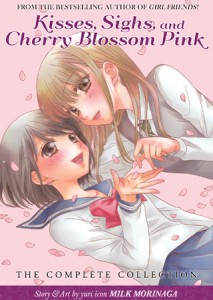By Milk Morinaga. Released in Japan by Futabasha, serialized in the magazine Comic High! (earlier stories serialized by Ichijinsha in the magazine Comic Yuri Hine). Released in North America by Seven Seas.
When I was growing up, the generally accepted “yes, you can now be nostalgic about this” period was about 20 years. Happy Days being the primary example, but the same thing applied as the 1980s wore on. Then, sometime around the early 90s, nostalgia started to speed up. Suddenly we can’t get enough of revisiting things that only happened 5-10 years ago. And this makes sense, given how fast culture has been moving lately thanks to the Information Superhighway and such. (See what I told you about nostalgia?) What this means in practice is that we can be startled that things we read only a few years back suddenly seem like products of a bygone age, and Kisses, Sighs and Cherry Blossom Pink is an excellent example.
When these stories first came out in 2003 or so, it was fantastic. They were in a magazine devoted exclusively to ‘yuri’ stories, and many of them sailed along based solely on that premise. Girls! In love with other girls! And even kissing and stuff! This particular story was actually a group of one-shots that ended up centering around the same school, which is attended by Nana and her friends (Hitomi’s school gets far less attention, possibly as it seems to be far less yuri-friendly). It’s not just Nana – there’s ghosts in love, and unrequited love, and a Takarazuka ‘prince’ who’s actually a bit of a weirdo. It’s a whole yuri subculture. And, in 2003, this was fantastic.
Why does it seem to old and cliched now? It’s partly because Morinaga Milk essentially rewrote and improved Nana and Hitomi’s story in Girl Friends a few years later for Futabasha (after first wrapping it up, as we see in the second volume of this collection.) But it seems to me to be primarily that this sort of story is now old hat. There’s so much more yuri out there, and not all of it has to be “Girl meets girl, girl likes girl, they like each other, the end.” Actually, at the time this collection went FURTHER than a lot of the stories in Yuri Hime. Nana and Hitomi are sexually active, and we see that – again, something that was a real wow in 2003.
But nostalgic doesn’t necessarily mean bad, it simply means “wow, I can’t believe this is only 10 years old”. These stories are cute and sweet, and even the story that doesn’t end with two girls getting together still manages to be adorable. There’s not a lot of “couples buying refrigerators” here – indeed, the manga ends literally right before Nana and Hitomi will have to do that – because in 2003, this was enough. Girls being gay and in love (well, as gay as they’re allowed to be – the word ‘lesbian’ isn’t used much here) at their local schools, and some of them even (gasp!) staying together after they leave school.
I really enjoyed this series, as it brought back a lot of happy memories, and the stories set up a lot of other series that I’ve also enjoyed that followed its example. Nana and Hitomi are sweet, everyone is happy (though the final Nanan and Hitomi story does have a deus ex machina so blatant you could drive a moving truck through it), and the series is quaint. Quaint and twee, you’re in 2003. Nostalgia is the new nostalgia. Recommended.


Pingback: MangaBlog — New releases, MMF call for entries
Fantastic review, Sean. Not only do you steal some of my best lines, the last, wholly original, line is a great zinger. If I had an award to give you, this review would get it! ^_^
I liked it and thought it was sweet. My only minor complaint with this book is that they could have used chapter breaks at times.. it was hard to tell where one story ended and the other began.
Actually, calling Kisses, etc. an “earlier” work isn’t completely accurate, as while the bulk of the omnibus is older material, Morinaga wrote a few additional stories in 2012 for a re-release of the anthology. While her art hasn’t changed much it in the intervening nine years, there are some slight differences in the art between the two eras, although Morinaga notes that she tried to match the style.
Pingback: Okazu » Yuri Network News (百合ネットワークニュース) – June 22, 2013
KSCBP was written in 2003, several years before the series GIRL FRIENDS, by the same author. Unlike Akko and Mari, Hitomi and Nana have to deal with their crises largely alone. Nana mentions that she and Hitomi have had sex but also wonders what counts as sex between two girls, and is upset that she has so many questions and nowhere to turn. It makes me wonder just how few resources there were for the LGBTQ community in Japan ten years ago. Hitomi is afraid that her love is preventing Nana from living a normal life and overcompensates by trying to be “manly.” Both are terrified of being found out, and near the end, they run away together, deciding that their relationship is more important than their friends and families. Their circumstances make KSCBP a more angsty series than GIRL FRIENDS, but also perhaps a more realistic look at the problems and misunderstandings a lesbian couple could have in a society that offers them no role models. It’s nice to see Morinaga addressing issues like these, which seems a bit unusual for her stories. But it’s not all sorrow and fear. The girls have plenty of good times together as they and their relationship mature, and they find that some friends are supportive. I think they have a good shot at keeping their promise to get married and to have their story continue forever.